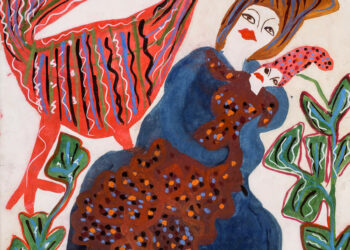The END Fund, announces ‘Reframing Neglect’, a new photography series creative directed by contemporary artist and activist Aïda Muluneh, highlighting the need to end neglected tropical diseases (NTDs) globally.

Aïda Muluneh, Crimson Echo, 2023. Courtesy of The END Fund.
The collection will be showing in partnership with The Africa Center, Harlem, from the 3rd of August until the 5th of September, before traveling to Cromwell Place London, on the 26th of September until the 8th of October, 2023. ‘Reframing Neglect’ includes photography by Messeret Argaw (b. Ethiopia, 1989), Mustafa Saeed (b. Somalia, b. 1986), Sarah Wasiwa (b. Uganda, 1980), John Kalapo (b. Mali, 1983), Omoregie Osakpolor (b. Nigeria, 1990) and Ala Kheir (b. Sudan, 1985).
The full series includes 38 photos by photographers from seven African countries; through fine art and documentary photography, the artists highlight the weight of NTDs on individuals and communities, using art as a tool of shared human emotion while addressing the need to spread awareness of neglected diseases.
The END Fund mobilises resources for NTDs and focuses on delivering treatments to those in need by growing and engaging a community of activist-philanthropists, managing high-impact strategic investments, and working in collaboration with government, NGO, pharmaceutical, and academic partners. To celebrate ten years of impact, the END Fund engaged Muluneh to create a body of work with photographers from across six countries in Africa impacted by NTDs: Ethiopia, Somalia, Kenya, Mali, Nigeria, and Sudan. Reframing Neglect includes photography by Messeret Argaw (b. Ethiopia, 1989), Mustafa Saeed (b. Somalia, b. 1986), Sarah Wasiwa (b. Uganda, 1980), John Kalapo (b. Mali, 1983), Omoregie Osakpolor (b. Nigeria, 1990) and Ala Kheir (b. Sudan, 1985).
Muluneh embeds multiple layers of narrative into each image to create a powerful interpretation of the impacts of NTDs on gender equity, mental health, mobility, and access to resources. Using bright colours and respect for tradition as her vehicle, Muluneh’s work dismantles renderings of a bleak and impoverished Africa. In her latest collection on view, titled The Crimson Echo (2021), Muluneh uses motifs of both insects (‘The Barriers Within’) and abstracted body parts (‘I Sail on The Memories of My Dreams’), which lend specific attention to the disease vectors and physical manifestations of NTDs that are often overlooked.
Sudanese photographer Ala Kheir layers photos of people and places in his series. Kheir highlights a neighbourhood on the outskirts of Khartoum known as the Stables Industrial Area, where families who flee unstable regions have made makeshift homes. His work highlights the people forced to find refuge in places that are not suitable to be homes. These new neighbourhoods have sprouted in the peripheries of the city, and it is where the majority of people living with NTDs reside.
Sarah Waiswa, a Ugandan-born, Kenya-based photographer, follows Eunice Atieno, a 48-year- old single mother who for 11 years has been living with lymphatic filariasis (LF), a disease caused by parasitic worms that is the leading cause of permanent disability worldwide. In its advanced stage, the disease leads to complications of swollen legs with rough, thickened skin and can occur in other parts of the body, including the scrotum. In 2019, Eunice was diagnosed with LF following a mass drug administration exercise that took place in her neighbourhood.
Somali documentary photographer and visual artist Mustafa Saeed focuses on dissecting the emotional turmoil that intestinal worms have on people impacted. Through colourful ropes and garments, Mustafa conveys the neglect and feeling of imprisonment from a disease that can easily be treated.
Malian photographer, John Kalapo, documents people living with NTDs in the Kita region of the country. Through formal portraits, he captures the physical impact of the disease while maintaining the dignity of the people he photographs. He focuses on documenting cases of river blindness and LF in the villages of Sagabary, Boukarybaye-Bohan, and Kita town.
Ethiopian photographer Meseret Argaw explores the social, economic, and mental health impact NTDs have on women living in rural communities in Ethiopia. Through conceptual pieces, she illustrates how NTDs force women into cycles of poverty.
Omoregie Osakpolor is an emerging documentary photographer living in Lagos, Nigeria. In this series, he documents the activities of END Fund partner, the Amen Foundation, which works on NTDs in Gombe, Nigeria. Nigeria has one of the highest rates of NTDs in the world, with over 166 million people at risk. The series illustrates the physical impact of NTDs on patients and how health workers are tackling the group of diseases in their communities.
As the END Fund continues to seek partnerships that elevate the voices of the communities in which they operate, Reframing Neglect serves as a testament to impactful storytelling and speaks to the urgency with which we must collectively act to address the burden of these neglected diseases and the impact they have on communities.
The Africa Center in New York will host the exhibition from the 3rd of August to the 5th of September, after which it will move to Cromwell Place in London from the 26th of September to the 8th of October, 2023. For more information, please visit The End Fund.



